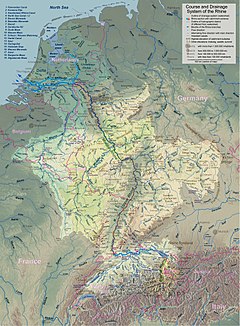| Rhine | |
|---|---|
 The Rhine in Basel, Switzerland | |
 Map of the Rhine basin | |
 | |
| Etymology | Celtic Rēnos |
| Native name |
|
| Location | |
| Countries | |
| Rhine Basin |
|
| Region | Central and Western Europe |
| Largest cities | |
| Physical characteristics | |
| Source | Vorderrhein (Sursilvan: Rein Anteriur) |
| • location | Tomasee (Romansh: Lai da Tuma), Surselva, Graubünden, Switzerland |
| • coordinates | 46°37′57″N 8°40′20″E / 46.63250°N 8.67222°E |
| • elevation | 2,345 m (7,694 ft) |
| 2nd source | Hinterrhein (Sursilvan: Rein Posteriur) |
| • location | Paradies Glacier, Graubünden, Switzerland |
| Source confluence | Reichenau |
| • location | Tamins, Graubünden, Switzerland |
| • coordinates | 46°49′24″N 9°24′27″E / 46.82333°N 9.40750°E |
| • elevation | 585 m (1,919 ft) |
| Mouth | North Sea |
• location | Netherlands |
• coordinates | 51°58′54″N 4°4′50″E / 51.98167°N 4.08056°E |
• elevation | 0 m (0 ft) |
| Length | 1,230 km (760 mi)[note 1] |
| Basin size | 185,000 km2 (71,000 sq mi) |
| Discharge | |
| • average | 2,900 m3/s (100,000 cu ft/s) |
| • minimum | 800 m3/s (28,000 cu ft/s) |
| • maximum | 13,000 m3/s (460,000 cu ft/s) |
| [2] | |
The Rhine[note 2] (/raɪn/ RYNE)[3] is one of the major European rivers. The river begins in the Swiss canton of Graubünden in the southeastern Swiss Alps. It forms the Swiss-Liechtenstein border and partly the Swiss-Austrian and Swiss-German borders. After that the Rhine defines much of the Franco-German border, after which it flows in a mostly northerly direction through the German Rhineland. Finally in Germany, the Rhine turns into a predominantly westerly direction and flows into the Netherlands where it eventually empties into the North Sea. It drains an area of 9,973 km2.
Its name derives from the Celtic Rēnos. There are two German states named after the river, North Rhine-Westphalia and Rhineland-Palatinate, in addition to several districts (e.g. Rhein-Sieg). The departments of Bas-Rhin and Haut-Rhin in Alsace (France) are also named after the river. Some adjacent towns are named after it, such as Rheinau, Rheineck, Rheinfelden (CH) and Rheinfelden (D).
The International Commission for the Hydrology of the Rhine Basin (CHR) and EUWID contend that the river could experience a massive decrease in volume, or even dry up completely in case of drought, within the next 30 to 80 years, as a result of the climate crisis.[4][5]
The Rhine is the second-longest river in Central and Western Europe (after the Danube), at about 1,230 km (760 mi),[note 1] with an average discharge of about 2,900 m3/s (100,000 cu ft/s).
The Rhine and the Danube comprised much of the Roman Empire's northern inland boundary, and the Rhine has been a vital navigable waterway bringing trade and goods deep inland since those days. The various castles and defenses built along it attest to its prominence as a waterway in the Holy Roman Empire. Among the largest and most important cities on the Rhine are Cologne, Rotterdam, Düsseldorf, Duisburg, Strasbourg, Arnhem, and Basel.
- ^ a b "Le Rhin" (official site) (in French). Paris, France: L'Institut National de l'Information Geographique et Forestrière IGN. Retrieved 6 March 2016.
- ^ Frijters & Leentvaar 2003.
- ^ "Rhine". Collins Dictionary (Online ed.). Retrieved 1 June 2023.
- ^ Stahl, K.; Weiler, M.; Van Tiel, M.; Kohn, I.; Hänsler, A.; Freudiger, D.; Seibert, J.; Gerlinger, K.; Moretti, G. (2022). CHR Report No. I-28: Impact of climate change on the rain, snow and glacier melt components of streamflow of the river Rhine and its tributaries (PDF). Lelystad: International Commission for the Hydrology of the Rhine Basin. p. 26. ISBN 978-90-70980-44-3.
- ^ Gerber, A. (6 July 2022). "Klimaforscher Latif: Rhein könnte bei Dürre austrocknen" [Climate researcher Latif: The Rhine could dry out in the event of a drought]. EUWID Wasser und Abwasser (in German). Gernsbach: EUWID Europäischer Wirtschaftsdienst. Retrieved 9 January 2023.
- ^ Schrader, C.; Uhlmann, B. (28 March 2010). "Der Rhein ist kürzer als gedacht – Jahrhundert-Irrtum" [The Rhine is Shorter Than Expected – The Mistake of the Century]. Süddeutsche Zeitung (in German). München.
- ^ "Rhine River 90 km shorter than everyone thinks". The Local. 27 March 2010. Archived from the original on 19 August 2022.
"We checked it out and came to 1,232 kilometers," said Ankie Pannekoek, spokeswoman for the Dutch government hydrology office.
Cite error: There are <ref group=note> tags on this page, but the references will not show without a {{reflist|group=note}} template (see the help page).